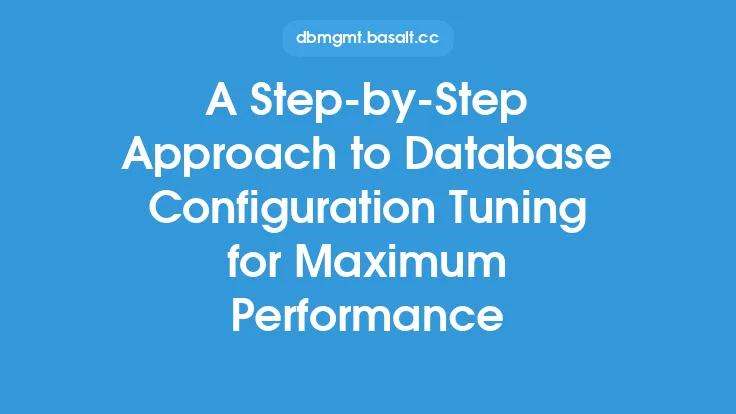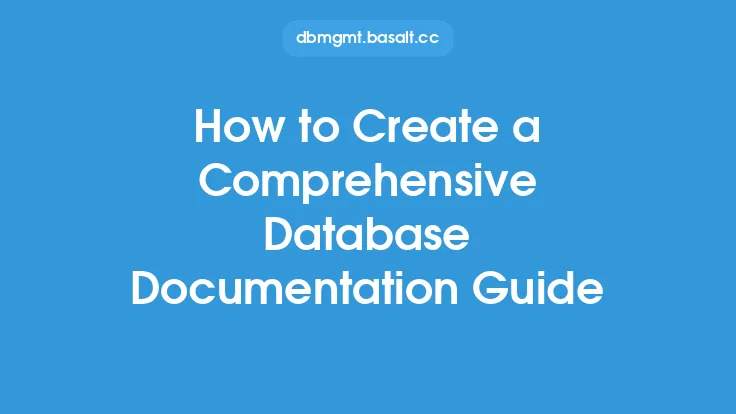Database parameter tuning is a crucial aspect of database configuration that can significantly impact the performance, scalability, and reliability of a database management system. It involves adjusting the settings and parameters that control the behavior of the database to optimize its performance, ensure efficient use of resources, and prevent potential issues. In this article, we will delve into the world of database parameter tuning, exploring the key concepts, techniques, and best practices for achieving optimal results.
Introduction to Database Parameters
Database parameters are settings that control the behavior of a database management system, influencing how it uses resources, manages data, and responds to queries. These parameters can be categorized into several types, including:
- Instance parameters: control the overall behavior of the database instance, such as memory allocation, process management, and logging.
- Session parameters: control the behavior of individual sessions, such as cursor management, sorting, and joining.
- Storage parameters: control the management of storage resources, such as disk space, file systems, and caching.
- Network parameters: control the communication between the database and clients, such as connection management, authentication, and encryption.
Identifying Key Database Parameters
To tune database parameters effectively, it is essential to identify the key parameters that have the most significant impact on performance. Some of the most critical parameters include:
- Buffer cache size: controls the amount of memory allocated to cache frequently accessed data.
- Sort area size: controls the amount of memory allocated to sorting operations.
- Hash area size: controls the amount of memory allocated to hash operations.
- Log buffer size: controls the amount of memory allocated to logging operations.
- Connection pool size: controls the number of connections available for client requests.
Techniques for Database Parameter Tuning
There are several techniques for database parameter tuning, including:
- Trial and error: involves adjusting parameters and monitoring the impact on performance.
- Benchmarking: involves running standardized tests to evaluate the performance of different parameter settings.
- Modeling: involves using mathematical models to predict the impact of parameter changes on performance.
- Monitoring: involves collecting data on database performance and using it to inform parameter tuning decisions.
Best Practices for Database Parameter Tuning
To achieve optimal results from database parameter tuning, it is essential to follow best practices, including:
- Start with a baseline: establish a baseline configuration and monitor performance before making changes.
- Make incremental changes: adjust parameters in small increments and monitor the impact on performance.
- Test and validate: test and validate changes before implementing them in production.
- Monitor and adjust: continuously monitor performance and adjust parameters as needed.
- Document changes: maintain a record of changes made to database parameters and the rationale behind them.
Common Database Parameter Tuning Challenges
Database parameter tuning can be challenging, and common issues include:
- Over-tuning: making too many changes, which can lead to instability and performance degradation.
- Under-tuning: making too few changes, which can fail to address performance issues.
- Interdependencies: parameters can interact with each other in complex ways, making it challenging to predict the impact of changes.
- Dynamic workloads: databases often experience dynamic workloads, making it challenging to optimize parameters for all scenarios.
Tools and Techniques for Database Parameter Tuning
Several tools and techniques can aid in database parameter tuning, including:
- Database management system (DBMS) built-in tools: many DBMS provide built-in tools for monitoring and tuning database parameters.
- Third-party tools: specialized tools, such as performance monitoring and tuning software, can provide detailed insights into database performance and parameter settings.
- Scripting and automation: scripting and automation can help streamline the tuning process and reduce the risk of human error.
- Machine learning and artificial intelligence: machine learning and artificial intelligence can be used to analyze performance data and predict optimal parameter settings.
Conclusion
Database parameter tuning is a critical aspect of database configuration that requires careful consideration and attention to detail. By understanding the key concepts, techniques, and best practices outlined in this article, database administrators can optimize database performance, ensure efficient use of resources, and prevent potential issues. Remember to start with a baseline, make incremental changes, test and validate, monitor and adjust, and document changes to achieve optimal results from database parameter tuning.





